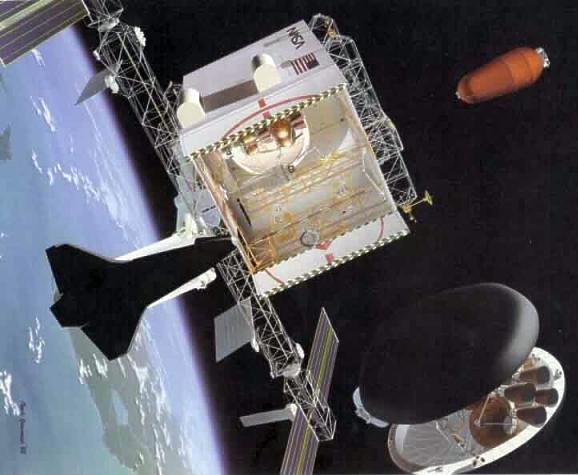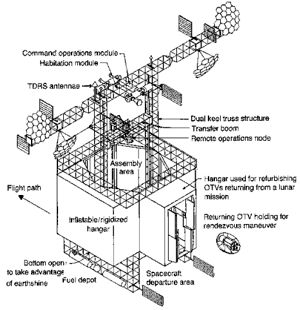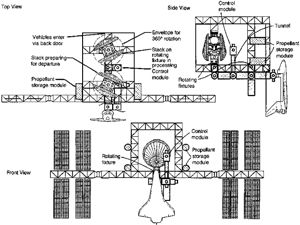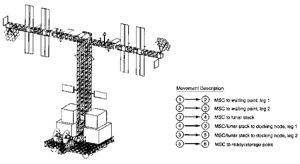
Home - Search - Browse - Alphabetic Index: 0- 1- 2- 3- 4- 5- 6- 7- 8- 9
A- B- C- D- E- F- G- H- I- J- K- L- M- N- O- P- Q- R- S- T- U- V- W- X- Y- Z
Spacedock

Spacedock 1988
Space Station Spacedock. This 1988 illustration depicts a large "Drive-thru" spacedock facility for assembly and checkout of manned lunar spacecraft.
Credit: NASA via Marcus Lindroos
American manned space station. Study 1986.
Status: Study 1986.
After the 1986 Space Shuttle Challenger accident, a number of space policy reports ('Pioneering the Space Frontier', 'Leadership and America's Future in Space') advocated an aggressive manned lunar/Mars program to restore America's lead in space. NASA now embarked on a number of studies to see how the downscaled Space Station Freedom could assist this goal. This would involve use of a large spacedock facility for assembly and checkout of manned lunar or planetary spacecraft.
Three designs were considered:
- The 'Drive-thru' spacedock would have weighed more than twice as much as the basic Space Station Freedom, which had an in-orbit mass of 200 metric tons. Lunar transfer vehicles would have been assembled, serviced and refueled in a rectangular enclosure on top.
- The 'Atrium' spacedock would also have utilized the same type of modules and structures as Space Station Freedom.
- The 'Platform' spacedock would have featured a large gravity gradient-stabilized extension at the bottom. The Canadian Mobile Servicing Center would have been capable of moving up and down this structure, transporting the lunar spacecraft stack along the way.
The 'Platform' and 'Atrium' versions would have been bigger than the 'Drive-Thru', but their overall operation (e.g. attitude control/stability) and maintenance might have been easier. Most NASA studies preferred to develop a separate spacecraft assembly and checkout facility in order to minimize the impact on sensitive experiments onboard Space Station Freedom. One version of the 'spacedock' would be connected to the Space Station by a long tether. A space tug could receive a free boost from the centrifugal forces when it was released from such a tether. An alternative free-flying 'spacedock' could be constructed from Space Station subsystems such as solar thermodynamic power generators, radiators, truss segments etc.. Tanks would contain rocket propellant for a space tug. The large walls on the side of the spacedock's box-like structure provided thermal protection.
Article by Marcus Lindroos
Family:
Space station,
USA - Space Stations.
Country:
USA.
Launch Vehicles:
Space Shuttle.
Agency:
NASA.
Photo Gallery
 | Spacedock
Space Station Spacedock. This free-flying "spacedock" would be constructed from Space Station subsystems such as solar thermodynamic power generators, radiators, truss segments etc.. The white tanks contain rocket propellant for the space tug.
Credit: NASA via Marcus Lindroos |
 | Atrium Spacedock
The "Atrium" spacedock would also have utilized the same type of modules and structures as Space Station Freedom.
Credit: NASA via Marcus Lindroos |
 | Tether and Spacedock
Space Station Spacedock. Most NASA studies preferred to develop a separate spacecraft assembly & checkout facility in order to minimize the impact on sensitive experiments onboard Space Station Freedom. This "spacedock" would be connected to the Space Station by a long tether. The space tug (top) will receive a free boost from the centrifugal forces when it releases the tether
Credit: NASA via Marcus Lindroos |
 | Spacedock
Space Station Spacedock. The "Drive-thru" spacedock would have weighed more than twice as much as the basic Space Station Freedom, which had an in-orbit mass of 200 metric tons. Lunar transfer vehicles would have been assembled, serviced and refuelled in the rectangular enclosure on top.
Credit: NASA via Marcus Lindroos |
 | Spacedock
Space Station Spacedock. The "Platform" spacedock would have featured a large gravity gradient-stabilized extension at the bottom. The Canadian Mobile Servicing Center would have been capable of moving up and down this structure, transporting the lunar spacecraft stack along the way.
Credit: NASA via Marcus Lindroos |
Back to top of page
Home - Search - Browse - Alphabetic Index: 0- 1- 2- 3- 4- 5- 6- 7- 8- 9
A- B- C- D- E- F- G- H- I- J- K- L- M- N- O- P- Q- R- S- T- U- V- W- X- Y- Z
© 1997-2019 Mark Wade - Contact
© / Conditions for Use






